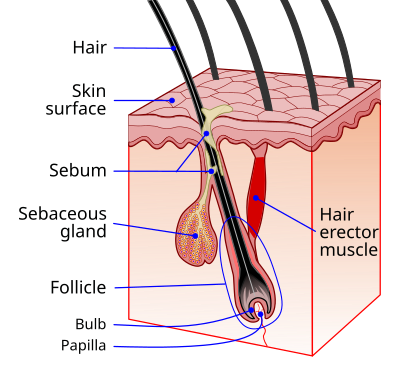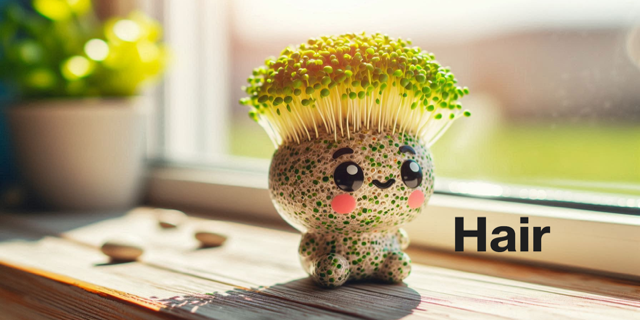We all have it, covering our bodies — except our palms and the soles of our feet.
But scalp hair is part of our body image, a sign of gender, youth and self-identity. Everyone knows about having a bad hair day. Yet, losing hair can negatively impact self-esteem.[1]
Still, how much do we know much about it, beyond shampooing, conditioning, coloring, shaping, cutting or losing it?
How does hair grow?
On average, we have over 100,000 scalp hairs. Hair grows at different rates all over our body. Scalp hair grows at a rate of a little less than half an inch a month. [2]

Each hair has a nerve, a tiny blood vessel, a sebaceous gland (oil- and/or sweat-producing gland) and a tiny muscle attached to its base.
Hair actually grows in cycles. The root of hair, or follicle, is below the skin surface, in the dermis, and is where growth actually occurs. There are two areas of the follicle, the outer and inner root sheath. The outer root sheath has a multitude of stem cells that can become any type of cell making up the hair.
When the hair follicle is in the active stage (called anagen growth phase), it looks like the bulb of an onion. During the anagen growth phase, these stem cells start to differentiate, or change into distinct types of cells, for example melanocytes (which gives our hair its color) and keratinocytes. The anagen phase of a scalp hair follicle can last from two to eight years.[3]
The second phase is the catagen or transition phase. The follicle starts to shrink in diameter and forms a “club hair.” This phase lasts around two weeks.
The third phase, when the hair follicle goes into a dormant or resting phase, is called the telogen phase. About 9 percent of scalp hair is in the telogen phase at any given time. Hair, with different functions, stay in the telogen phase for varying periods of time. For example, eyelash follicles may rest for only a few weeks while head or scalp hair follicles may rest for almost a year.
Exogen is the shedding stage of the hair growth cycle. [3]
Each hair goes through its own follicle cycle – anagen, catagen, telogen and exogen – recurring or beginning back at the anagen growing phase 10 to 30 times in a lifetime.[4]
There is a healthy balance of hair follicles in anagen versus telogen phase from around 12-14 hairs in anagen phase to 1 in the telogen phase. Keeping the ratio of anagen to telogen in that range means no reduction in hair. Increases of hair in the telogen phase means more hair loss. [5]
Factors Influencing Hair Loss
- Age affects two aspects of hair follicles and their anagen phases. First, the anagen phase length decreases with age, resulting in weaker and thinner hair over time. Second, the proportion of follicles in the anagen phase declines with age.
- A large number of studies have found that chronic inflammation, involving white blood cells (lymphocytes and histiocytes) causes hair loss.
- Hormones like thyroid hormones, estrogen and testosterone can put hair follicles into the telogen phase. In fact, generalized hair loss (also called diffuse hair loss) can actually be a sign that something is wrong with your thyroid gland function. Dihydrotestosterone (DHT) promotes male patterned baldness, shortening anagen growth phase and elongating the telogen phase. Reduced estrogen, which occurs in women after menopause, can also reduce hair density and decrease the anagen phase length.
- Stress
- Nutritional deficiencies
- Poor sleep
- Chemotherapy and other medications that affect cell division [5]
Ways to Increase Hair Growth
There are some hair growth medications available to help move more hair follicles from the telogen rest phase into the anagen growth phase.
Minoxidil has been approved orally and topically by the FDA for androgenic alopecia (male and female patterned baldness) which may have genetic and environmental causes. It relaxes blood vessels and increases blood flow to the hair. One of its side effects is hypertrichosis, or excessive hair growth in any part of the body.[5] In a small 2017 study comparing low light therapy (exposure to low levels of red and near infrared light), researchers found comparable results with minoxidil for women with female patterned baldness. Combining the two therapies seemed to improve results. [6].
Finasteride has been approved by the FDA for oral use but not topically (or spray on) for male patterned baldness. Finasteride is also approved to treat benign prostatic hyperplasia. It acts by stopping the production of one type of testosterone in the body to another, so reducing the activate form of the hormone. Finasteride has a number of side effects that are concerning, specifically post-finasteride syndrome: “Post-finasteride syndrome (PFS) is a constellation of serious adverse side effects manifested in clinical symptoms that develop and persist in patients during and/or after discontinuing finasteride treatment in men with pattern hair loss (androgenetic alopecia) or benign prostatic hyperplasia. These serious adverse side effects include persistent or irreversible sexual, neurological, physical and mental side effects.”[7] There is a topical product combining minoxidil and finasteride which has caused some controversy.
For people with alopecia areata (AA), an autoimmune disease where the immune system attacks hair follicles, there is a new medication available called LITFULO. The FDA approved this drug for people aged 12 years and older with this disease. In clinical trials, almost 25 percent of those treated with the medication experienced with 50 mg of the medication experienced 80 percent or more scalp hair coverage compared with those taking the placebo.[8] Another medication for adults with AA, called BARICITINIB, was also approved in 2023.[9]
Additionally, a 2022 review of 30 journal articles on nutritional interventions — including 17 randomized clinical trials (RCTs), 11 clinical studies (non-RCT), and two case series studies — was published in JAMA Dermatology. The lead author of the review stated in an interview that he would like the studies and trials to have been on larger populations with more rigorous criteria.[10 ] However, his review article noted that “studies of Viviscal, Nourkrin, Nutrafol, Lamdapil, Pantogar, capsaicin and isoflavone, omegas 3 and 6 with antioxidants, apple nutraceutical, total glucosides of paeony and compound glycyrrhizin tablets, zinc, tocotrienol, and pumpkin seed oil demonstrated the highest-quality evidence for potential benefit.”[11]
Finally, a small study on using scalp massage showed promising results in terms of total hair number, hair thickness, and hair growth rate. Plus, analysis of gene expression showed a positive trend in genes promoting hair growth.
It’s Not “Only” Hair
People might say, “it’s only hair,” but, in fact, they are wrong. Loss of hair should be discussed with your physician. It could be a symptom of a serious condition or a reaction to medication. But importantly, it is an expression of you. Be careful of non-FDA approved medications. But the healthy strategies to address hair loss—improved sleep, reduced stress, scalp massage, and the others discussed above are definitely worth trying.
References
1.Aukerman EL, Jafferany M. The psychological consequences of androgenetic alopecia: A systematic review. J Cosmet Dermatol. 2023 Jan;22(1):89-95. doi: 10.1111/jocd.14983. Epub 2022 Apr 25. PMID: 35403805; PMCID: PMC10084176.
2.Harrison S, Bergfeld W. Diffuse hair loss: its triggers and management. Cleve Clin J Med. 2009 Jun;76(6):361-7. doi: 10.3949/ccjm.76a.08080. PMID: 19487557.
3. Paus R, Cotsarelis G. The biology of hair follicles. N Engl J Med. 1999 Aug 12;341(7):491-7. doi: 10.1056/NEJM199908123410706. PMID: 10441606
4. Hoover E, Alhajj M, Flores JL. Physiology, Hair. [Updated 2023 Jul 30]. In: StatPearls [Internet]. Treasure Island (FL): StatPearls Publishing; 2024 Jan-. Available from: https://www.ncbi.nlm.nih.gov/books/NBK499948/
5.Natarelli N, Gahoonia N, Sivamani RK. Integrative and Mechanistic Approach to the Hair Growth Cycle and Hair Loss. Journal of Clinical Medicine. 2023; 12(3):893. https://doi.org/10.3390/jcm12030893
6.Esmat SM, Hegazy RA, Gawdat HI, Abdel Hay RM, Allam RS, El Naggar R, Moneib H. Low level light-minoxidil 5% combination versus either therapeutic modality alone in management of female patterned hair loss: A randomized controlled study. Lasers Surg Med. 2017 Nov;49(9):835-843. doi: 10.1002/lsm.22684. Epub 2017 May 10. PMID: 28489273.
7. Traish AM. Post-finasteride syndrome: a surmountable challenge for clinicians. Fertil Steril. 2020 Jan;113(1):21-50. doi: 10.1016/j.fertnstert.2019.11.030. PMID: 32033719.
8.FDA Approves Pfizer’s LITFULO™ (Ritlecitinib) for Adults and Adolescents With Severe Alopecia Areata. (2023, June 23). https://www.pfizer.com/news/press-release/press-release-detail/fda-approves-pfizers-litfulotm-ritlecitinib-adults-and#:~:text=(NYSE%3A%20PFE)%20announced%20today,for%20LITFULO%20is%2050%20mg.
9. Baricitinib. (2023). Medscape. https://reference.medscape.com/drug/olumiant-baricitinib-1000107
10. Kronemyer, B. (2023, Jan. 18) Nutritional Supplements to Treat Hair Loss. Dermatology Times, January 2023 (Vol. 44. No. 01). https://www.dermatologytimes.com/view/nutritional-supplements-to-treat-hair-loss
11.Drake L, Reyes-Hadsall S, Martinez J, Heinrich C, Huang K, Mostaghimi A. Evaluation of the Safety and Effectiveness of Nutritional Supplements for Treating Hair Loss: A Systematic Review. JAMA Dermatol. 2023;159(1):79–86. doi:10.1001/jamadermatol.2022.4867
12. Koyama T, Kobayashi K, Hama T, Murakami K, Ogawa R. Standardized Scalp Massage Results in Increased Hair Thickness by Inducing Stretching Forces to Dermal Papilla Cells in the Subcutaneous Tissue. Eplasty. 2016 Jan 25;16:e8. PMID: 26904154; PMCID: PMC4740347.







